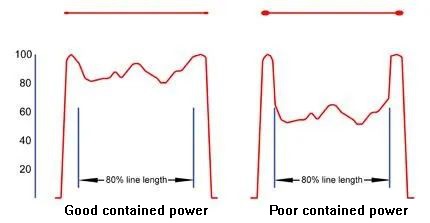Powell prism is an optical line generator prism that optimizes the laser beam into a straight line with uniform light density, good stability, and excellent linearity after passing through the prism. Powell prism produces lines superior to cylindrical lens line generation, eliminating the central hot spot and fading edges typical of Gaussian beams.
When Gaussian laser beams pass through ordinary cylindrical lenses, they produce unevenly distributed lines. In contrast, the top of the powell prism is a complex two-dimensional aspherical surface that generates considerable spherical aberrations as the laser passes through. This redistributes the light path, reducing the center region light while increasing the edge light to form an evenly distributed line, suitable for various machine vision applications such as biomedical, automotive assembly, and food processing.
The fan angle is a function of the glass refractive index and apex angle. The higher the top tilt angle and the larger the glass refractive index, the larger the fan angle for the same projection distance. Small fan angles typically use optical glass with a refractive index of n=1.5 , while large fan angles often use high refractive index glass of n=1.8 or increase the top tilt angle.
Available stock includes prisms with diameters of 6mm and 8.9mm, with fan angles of 1°, 5°, 10°, 15°, 20°, 30°, 45°, 60°, 75°, 90° . Custom prism designs and manufacturing for special applications are accepted, with low one-time design costs.
Laser beam size determines the thickness of the laser line for a given projection distance. A collimated laser beam with an elliptical cross-section may produce two broad or narrow lines.
For narrow incident light direction, where the laser main axis is parallel to the prism top, narrow laser incident creates a small depth of field. For wide incident light direction, where the laser axis is perpendicular to the prism top, wide laser incident creates a large depth of field.
The performance of powell prism is determined by the characteristics of the incident laser and the quality of the lens's aspherical surface. Selecting a prism that matches the laser module can generate a uniform laser line, fulfilling high application requirements.
For uniformly illuminated laser lines, the central 80% of the length must account for more than 80% of the total intensity. If the energy in the middle part is too low, the brightness at both ends will increase. Reducing the brightness at both ends helps improve the overall efficiency of laser utilization. The illustration below shows the differences in light intensity distribution in the central region for laser lines with the same uniformity.

The straightness and aperture deviation of the line depend on the manufacturing quality of the prism and the precision of laser module installation. If the laser does not incident perpendicularly, the line curvature arises, and there will be aperture errors between the wedge top and the bottom exit surface of the prism, eventually causing a deviation from the target position. If the prism is installed correctly, the wedge top of the prism only creates a slight tilt, resulting in minimal line curvature.
The laser beam width determines the prism's performance and physical characteristics. The most notable difference is the position of the divergence angle on the exit surface, ensuring that the diverging beam does not exceed the lens size.
The non-linear spherical surface of the prism will cause an uneven distribution as the beam passes through, so selecting an appropriate prism based on the laser beam diameter is necessary. The prism bottom exit plane must be larger than the beam cross-section on that plane. Standard 90° prisms are only suitable for broad incident laser beam expansion.